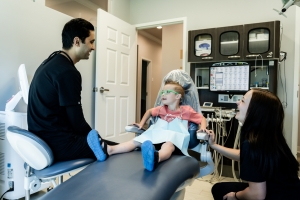Please note we may not offer this service at our office. Contact (614) 771-6060 for more information.
Your Guide to Pulpotomy Treatment
The term pulpotomy might seem daunting to parents whose children require dental care. This procedure addresses decay in baby teeth and helps prevent further issues. Pulpotomy is an endodontic treatment aimed at preserving the healthy portion of a primary tooth’s pulp while removing the infected area.
Learn more about this pediatric dentistry procedure by reaching out to our Hilliard, OH, dentist at (614) 771-6060.

What Is Pulpotomy?
A pulpotomy is a dental procedure that involves removing infected pulp tissue from a child’s primary tooth while preserving as much of the healthy pulp as possible. The pulp is the soft tissue inside a tooth that contains blood vessels, nerves, and connective tissue. This procedure serves as a more conservative alternative to pediatric root canal therapy for children experiencing issues with their primary teeth.
Pulpotomy procedures can also be performed on permanent teeth in certain situations where the pulp is damaged but the root structure remains healthy enough to support the tooth. However, root canal therapy is generally the preferred method for addressing pulp-related issues in permanent teeth.
When Is a Pulpotomy Necessary?
A pulpotomy is typically required when a child’s tooth is compromised by tooth decay. The tooth generally has extensive caries that have impacted the pulp within the crown but have not yet reached the roots, leading to pulpitis.
Pulpitis refers to the inflammation of the pulp tissue, which can result in pain, sensitivity to temperature changes, and difficulties with eating. If not addressed, pulpitis may cause the infection to spread to the tooth’s roots, potentially resulting in an abscess, swelling, and pain.
The Benefits of a Pulpotomy
A pulpotomy offers several advantages for children’s dental health, including:
- Preservation of the Tooth: By removing the infected pulp tissue and preserving the healthy pulp, a pulpotomy can save a tooth from extraction. Primary teeth are crucial for maintaining space for permanent teeth and assisting in speech and chewing.
- Pain Alleviation: Pulpitis can cause significant pain and discomfort in children. A pulpotomy can relieve the pain by eliminating the source of inflammation and infection.
- Infection Prevention: A pulpotomy can prevent the infection from spreading to the tooth roots, which could result in an abscess and swelling.
- Cost-Effectiveness: Pulpotomy is a more affordable option compared to tooth extraction, potentially saving parents money over time.
The Pulpotomy Process
Numbing the Area
To begin the pulpotomy procedure, the dentist will administer a local anesthetic to numb the area around the affected tooth, ensuring your child remains pain-free throughout the process.
Isolating the Tooth
The dentist will then isolate the primary tooth using a rubber dam, keeping it dry and protected from saliva and other contaminants.
Removing Damaged Tissue
Next, the decayed or damaged tissue is carefully removed from the tooth’s pulp chamber with specialized dental instruments.
Applying Medication
The dentist will apply medication to the remaining healthy pulp tissue to promote healing and prevent further decay or infection.
Placing a Restoration
The pulp chamber is then filled with a dental restoration material, typically a stainless steel crown, to safeguard the tooth and provide structural support.
Removing the Rubber Dam and Aftercare Instructions
Finally, the rubber dam is removed, and the dentist will provide the child and parent with guidance on what to expect following the pulpotomy procedure
Pulpotomy Aftercare
Following a pulpotomy, it is essential to adhere to the dentist’s aftercare instructions to ensure proper healing and maintenance of the tooth’s health. Here are some aftercare tips for a pulpotomy:
- Pain Management: Administer child-safe over-the-counter pain relievers as recommended by the dentist. If the pain persists or intensifies, contact the dentist.
- Oral Hygiene: Encourage your child to brush their teeth twice daily and floss once a day to prevent further decay or infection.
- Eating Habits: Refrain from giving your child hot or crunchy foods until the anesthetic wears off completely. Opt for soft foods that are easier to eat and less likely to irritate the tooth.
- Follow-up Appointments: Attend all scheduled follow-up visits to ensure proper healing of the tooth and the stability of the dental restoration material.
- Prescribed Medications: Ensure your child takes any prescribed medications or mouthwash as directed by their dentist.
Possible Risks and Complications
As with any other dental procedure, there are risks present and the possibility of complications occurring:
- Infection: The primary goal of a pulpotomy is to eliminate infected or inflamed pulp tissue from the tooth’s crown to halt the spread of infection. However, if some infected tissue remains or bacteria enter during or after the procedure, an infection might still develop. Symptoms of infection include intense pain, swelling, pus discharge, and fever.
- Pain or Sensitivity: Experiencing pain or sensitivity after the procedure is common and usually diminishes within a few days. This discomfort can stem from inflammation due to the procedure or may signal an infection. Sensitivity to hot and cold can also occur. If pain or sensitivity is severe or persists beyond a few days, consult your dentist.
- Bleeding: Minor bleeding is normal immediately following a pulpotomy. However, heavy or prolonged bleeding beyond a day could indicate a problem that should be reported to your dentist.
- Failure of the Procedure: The success of a pulpotomy depends on the health and infection-free status of the remaining dental pulp in the tooth’s root. If this is not the case, the procedure may fail. Signs of failure include pain, sensitivity, tooth discoloration, or an abscess forming at the tooth’s root. In such instances, a more comprehensive procedure, like a root canal or extraction, may be required.
- Allergic Reaction to Medication: Though rare, some patients may experience an allergic reaction to the medicated dressing used in a pulpotomy. Symptoms of an allergic reaction include rash, itching, swelling, dizziness, and difficulty breathing.
- Tooth Discoloration: Occasionally, the medicated dressing used during the procedure can lead to tooth discoloration.
- Injury to Surrounding Tissues: Although infrequent, there’s a slight risk that the instruments used during a pulpotomy could accidentally damage nearby teeth, gums, or other oral tissues.
Frequently Asked Questions
How long does a pulpotomy take?
A pulpotomy typically takes about 30 to 60 minutes to complete. This depends on the extent of the decay and the child’s cooperation during the procedure. Your dentist will provide a treatment timeline at your initial consultation.
Is a pulpotomy the same as a root canal treatment?
A pulpotomy is similar to a root canal treatment but is typically performed on baby teeth. In a root canal treatment, the entire pulp chamber and root canal system of the tooth is removed and filled with dental restoration material. In a pulpotomy, only the infected pulp tissue is removed, and the remaining healthy pulp is left in place.
Do you need a crown after a pulpotomy?
Yes. It’s recommended to place a dental restoration material, usually a stainless steel crown, after a pulpotomy to protect the tooth and provide structural support. The crown is placed over the remaining tooth structure and is cemented in place. The dental crown will also help prevent future decay or infection in the tooth.
Restore Your Child’s Oral Health with a Safe Pulpotomy
A pulpotomy effectively removes infected pulp tissue while preserving the healthy portion, ensuring your child’s oral health and development remain on track. If your child is experiencing discomfort or sensitivity in their baby teeth, it is important to seek dental care promptly to assess the need for a pulpotomy.
If you have any questions or concerns, call our dentist in Hilliard at (614) 771-6060. We proudly serve patients from Columbus, Dublin, Upper Arlington, Grove City, Westerville, and the surrounding areas.







